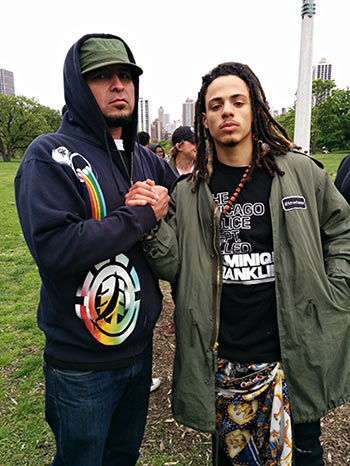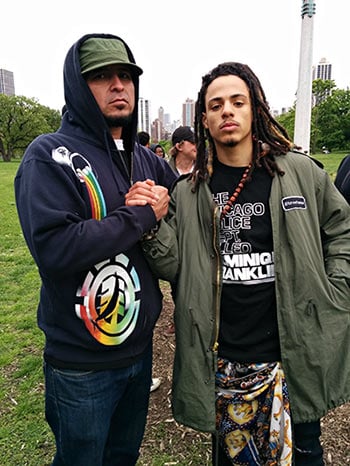 Young Black organizer and performing artist Ethan Viets-VanLear and Remy, a Diné, Navajo direct action trainer, worked in creative collaboration to combat police violence in Chicago in May 2015. (Photo: Kelly Hayes)Help Truthout keep publishing stories like this: They can’t be found in corporate media! Make a tax-deductible donation today.
Young Black organizer and performing artist Ethan Viets-VanLear and Remy, a Diné, Navajo direct action trainer, worked in creative collaboration to combat police violence in Chicago in May 2015. (Photo: Kelly Hayes)Help Truthout keep publishing stories like this: They can’t be found in corporate media! Make a tax-deductible donation today.
As the movement for Black Lives enters its second year, some non-Black activists, like myself, have been moved to think critically about the intersections of struggles within the Black community and the struggles of our own peoples. As an Indigenous activist, I am moved by the knowledge that the same structures that have long maintained both Black and Native disposability continue to crush our young people, and brutalize our communities. But despite these intersections, our efforts to build forward together have at times fallen into crisis, and the work of reconciling our differences has often been left undone.
During the last year, from Baltimore to Oakland, Indigenous activists have come out in support of Black lives. While there have been some moments of disagreement, many Native people have successfully adopted supportive roles in the Black Lives Matter movement. While Indigenous people are killed at a higher rate by police than any other racial group in the United States – as highlighted by the recent cases of Paul Castaway and Sarah Lee Circle Bear – many Native activists see the value in investing our efforts in a movement for Black liberation and survival. Both of our communities live in the shadow of genocide and historical trauma, and many of us believe that neither of our communities can be free without the liberation of the other.
Some organizers, both Black and Native, firmly believe that building forward at the intersections of our movements could lead to the development of a new praxis, one that could bring the kind of liberation that many are only now learning to imagine, but such efforts involve a number of complex stumbling blocks.
A Complicated History
As the child of a father who had been removed from the Menominee Reservation prior to the American Indian Child Welfare Act, I could have easily drifted through my young life without any connection to Native culture, outside of the Mystical Indian narratives of modern film and television. Fortunately, my family serendipitously connected with a member of our tribe who was deeply connected to our culture. Esther, who in time became a full-fledged medicine woman, taught my sister and I tribal dances and told us stories from her time with the American Indian Movement (AIM). Through her heartbreaking tales of resisting the forced sterilization of our women and displacement of our children, I experienced the first stirrings of my radical imagination.
In my teenage years, I read more deeply into the history of AIM, including the 1973 siege at Wounded Knee. As hundreds of Oglala Lakota and AIM supporters occupied the town of Wounded Knee, South Dakota, in protest of corruption and in defense of their own lives, law enforcement responded with militarized force. Armored personnel carriers, grenade launchers and other tools of war were brought to the boundaries of the siege. While media coverage was heavy, and public sympathy for the Indigenous activists was uncharacteristically high, activists feared that coverage of other major news stories would soon eclipse their struggle, and that law enforcement would roll through the town, inflicting violence indiscriminately.
Social, physical and political subjugation have always been the norm for both Black and Native peoples under this government.
The legacy of the land the resistors were occupying encapsulated both their historical grievances and their fears of looming reprisal. During the original Wounded Knee massacre of 1890, government soldiers on horseback rode down men, women and children. Infants and the elderly alike fell dead in the snow as a people’s collective hope was punished by the state. The massacre was an effort to stomp out the Ghost Dance movement, which was a Native cultural and spiritual movement that had spread through most of the western United States near the end of the 19th century. The ghost dancers believed that a transformation was possible, and that a spiritual rebirth and return to the old ways would bring back the buffalo and repel the colonizers. The US government had no regard for Native spiritualism, but no doubt recognized the danger of an oppressed people investing themselves in a belief that their salvation was possible.
So, nearly a century later, AIM held the Knee, and waited each day for the public’s attention to fade, and for the standoff’s violence to intensify.
Amid my readings on these events, I eventually came across a story I had never heard before, and have rarely heard discussed in the years since. Angela Davis, the Black freedom fighter and scholar who authored Are Prisons Obsolete?, actually traveled to the boundaries of the siege and attempted to join the Wounded Knee protesters. She was turned away by law enforcement at the town’s border as an “undesirable” person.
As I read of her attempt to join the resistors, I thought, Davis had to know that such a response from law enforcement was likely. She was already well known and well respected for her radical beliefs and aspirations, and was definitely viewed as a threat by the power structure. Then I thought about the threat of waning media attention, and it occurred to me: Showing up, by itself, was a defensive act. Davis used her prominence to create a news story, and for those living in struggle within the siege, visibility was life.
While most of us cannot offer a spotlight or renowned radical voice by showing up for natural allies, Davis’ appearance at the siege imparted something to me. In moments of great significance, we have to bring what we can, and do what we can, because the same structures have always been at war with both Black and Native bodies.
The role of Black soldiers in the subjugation of Native peoples was viewed by some as a point of pride.
Black bodies have always been abused, controlled and subject to social death in order to facilitate their commodification. Even the 13th Amendment provided a loophole in the abolition of slavery, allowing the practice to continue within the US prison system. Thus, the Black Codes and the prison industrial complex have allowed slavery to reinvent itself across the course of US history, just as displacement, forced relocation, the toxification of land, forced sterilization and the intentional maintenance of poverty have allowed the government to continue to pursue its primary goal with regard to Native bodies – our total annihilation. Social, physical and political subjugation have always been the norm for both Black and Native peoples under this government. While the mechanisms of our respective genocides have always had different aims, both have been enforced by the same structures for the sake of colonial dominance, with horrific consequences.
Throughout its development as a young empire, the United States has needed a narrative to propel its ascension. In order to create the idea of “America,” a great country with inherently great people, a national identity needed to be manufactured, and “Americans” had to be created. Assimilation has always been a path to privilege in the United States. American nationalism fashions a glorious identity for those who accept the erosion of their heritage, and embrace the shared plainness of the most elite identity our country has to offer – that of the white American.
The idea of America was a bright and shining lie, and a very appealing one, but the architects of that lie encountered a number of impediments. There were human obstructions, for example, whose annihilation had to be woven into a cultural identity that celebrated the idea that all men were created equal. Thus, a narrative of righteous conquest was written, the extermination of Indigenous peoples continued and a dehumanized Black workforce was shackled to the task of building a new empire.
Few people realize that Indian constables, who policed increasingly displaced Native populations during the early stages of US colonialism, and slave patrols, which captured Black slaves who had escaped their white masters, were this country’s first police. To understand these historical origins – along with the present state of law enforcement and the mechanics of the prison industrial complex – is to understand that the role of police in the United States has done little more than refashion itself over time. The main function of US policing remains the same: the management of people who have historically been identified as human resources, or human hindrances, by the prevailing power structure.
Law enforcement, in functionality, remains the same as it ever was.
Despite profound moments of cooperation and shared struggle between Black and Indigenous movements – which have included such moments as Indigenous people harboring and building community with escaped and former slaves – there is much to reconcile about the intersections of our shared histories. Some believe, for example, that Ray Robinson, a Black civil rights activist, was killed by members of AIM in 1973, during the siege at Wounded Knee. Robinson, who reportedly joined the protesters, disappeared during the chaos of those events. While AIM members claim that Robinson left of his own volition, some have held fast to the belief that AIM members, suspecting that Robinson was a government spy, killed him as a matter of tactical security. Regardless of which narrative is true, there is certainly a historical grounding for suspicion and disconnect between Black and Indigenous people.
Some Native people owned Black slaves until the practice was ended by treaty at the close of the Civil War.
In my own experience, I have found that dialogues about Native and Black relations often lack a shared historical understanding. This is unsurprising, given that both Black and Native people are constantly at odds with the erasure of their respective histories in the United States. The work of telling our own stories, and forcing honest dialogues about the harms perpetrated against our peoples, is at times exhausting. The history of our experiences is softened, sanitized and whitewashed in classrooms and popular entertainment. But living on the front lines of our own struggles sometimes means missing the opportunity to share in the pursuit of social and political transformation.
Even in social justice circles, I have encountered few Black people who are familiar with the role that the so-called Buffalo Soldiers played in Native displacement during westward expansion. However, in Native communities, stories of the Black soldiers who fought for the North during the Civil War, being turned toward the West in the war’s aftermath have not been forgotten. The role of Black soldiers in the subjugation of Native peoples was viewed by some as a point of pride. “We made the West,” Tenth Cavalry Pvt. Henry McCombs, a Black Buffalo soldier, declared in 1895. “[We] defeated the hostile tribes of Indians; and made the country safe to live in.” And while stories of the bravery exhibited by Black soldiers during the Civil War are well known, stories of Black soldiers participating in campaigns of violence against Native people, including the government’s 1890-91 Wounded Knee campaign, are far less discussed outside of Native communities.
Similarly, one will rarely hear discussion, in Native circles, of the sad reality that some Native people owned Black slaves until the practice was ended by treaty at the close of the Civil War. While the institution was rare among Native people – with less than 3 percent of Natives owning slaves at the height of the practice – it is nonetheless a dark stain in Native history, and one that most are not eager to revisit. With Black people in the United States attempting to build forward in the afterlife of slavery, living with the cultural re-memory of its horrors, a failure to fully speak to this entanglement of Native culture with one of this country’s darkest realities has no doubt created a barrier to dialogue, and contributed to various rifts between Native and Black populations.
While many Native people question the collective blame heaped upon over 500 nations for the actions of the small fraction of the Native population that owned slaves, it is important to remember that Blackness is likewise not a monolith. Native people, like Black people, are often understood collectively. This is a reality that is also experienced by Black Americans, despite their varied origins, and any dismantling of these socially constructed ideas can only occur through dialogue.
While Native and Black people have at times fought alongside each other, recognition of the ways in which both groups have replicated the harms of colonialism is clearly necessary if the two groups are to build forward in solidarity.
As William C. Anderson, a Black author who frequently addresses issues of race, told me recently:
It’s important we work together to seek collective liberation. However, we have to do that in a way that engages both anti-Blackness and Native genocide. We have to work together in sustainable ways that are real … we have to build with one another, not against. We should do so in a way that recognizes grievances, but still puts freedom first.
A process of social transformation, which not only acknowledges the harms experienced on both sides, but also seeks to root out the reasons why we have at times failed one another, would no doubt be a massive undertaking. However – recognizing that harmed individuals and communities in turn commit harms, often in the same rhythms – many believe that a process of healing is long overdue. And in some places, it may have already begun.
The Language of Oppression
With some Black and Brown activists working to build coalitions, conflicts still manifest themselves. At times, these conflicts are not only grounded in a failure to reconcile history, but also a failure to establish an actual language of understanding. Questions about the vocabulary of both our suffering and liberation emerge and stir discord between potential allies.
Is it acceptable for Native people to use a #NativeLivesMatter variation of the #BlackLivesMatter hashtag? Does the language of “colonization” apply to both the Black and Indigenous experience? Is language addressing the particular struggles of Native people adequately incorporated into conversations about police violence?
“Indigenous people deserve their own grammar of suffering as do Black people.”
Page May is a young Black organizer with We Charge Genocide in Chicago, and the cofounder of the Assata’s Daughters collective. May has been confronted with the complexities of Black and Native vocabularies of oppression in movement spaces, and recently noted to Truthout that “in Chicago, and elsewhere, there’s a lot of conversation in Black communities about naming our own struggles.” While these conversations do afford a level of separateness, May does not believe that making historical and cultural distinctions is necessarily harmful to solidarity efforts. “I hope [these conversations] aren’t read as Black people trying to distance themselves from Indigenous struggle,” she explains. In actuality, May says that she worries “about Black people appropriating Indigenous struggle with words like ‘decolonization’ and ‘genocide.’ Indigenous people deserve their own grammar of suffering as do Black people.”
In contrast to Indigenous people, who have always existed in resistance to erasure under colonization, Page says, “Blackness is always positioned as alienated from a place of origin – as having no Nativeness, as though Blacks are produced through dungeons – in a state of natal alienation.” In May’s view, this narrative othering, which forces Blackness out of any context of its own, holds Black people in a chattel state, shuffled from exploitation to exploitation without any cultural narrative but the experience of social death.
While May speaks of a cyclical narrative that entraps Blackness, some who come from Native backgrounds feel that their struggle is wholly erased in the popular dialogue. “When I tell people the numbers, and explain that police kill us at a higher rate than they kill anyone,” a young Native woman told me recently, “they act like that can’t be real. Like the statistics must be skewed in some way. I just want to yell at them: Yes, they are skewed! White supremacy skewed them by killing so many of us that you don’t notice us die anymore!”
But the lack of notice, this young woman explained, is not the most disturbing thought she attaches to these exchanges. “The worst thought, what I try not to believe, is that people, both other people of color and white people, that they do understand, and don’t care, because people have accepted the idea of us fading out. Like it’s already happened, so we’re not worth fighting for.”
The young Native woman I spoke to, who asked that her name not be shared publicly, is not alone in her concern that Native struggles with police violence are not being widely recognized or discussed. As Derek Royden recently wrote:
The Black Lives Matter movement has made a significant impact in part because African Americans are a visible presence in America’s large urban areas. By contrast, Native Americans are more easily ignored since they often live in more rural areas and on reservations.
Aware of such concerns, Page May speaks to the issue of Native erasure by insisting that “we have to take time to highlight the Indigenous resistance that is a part of our struggle. There is a long history of Black and Indigenous people working together to support one another’s movements.”
While May feels that there is great importance in forming distinct cultural frames around our differing experiences, she notes that “the goal of giving unique names to our struggles is not exceptionalism. It’s being better prepared for understanding what actual solidarity means.”
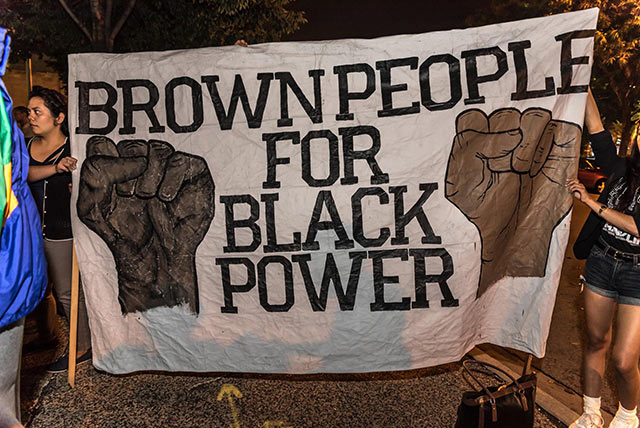 Banner seen at a recent #SayHerName rally in Chicago, where protesters demanded that Chicago police officer Dante Servin be fired for shooting and killing Rekia Boyd, an unarmed Black person. (Photo: Sarah Jane Rhee)
Banner seen at a recent #SayHerName rally in Chicago, where protesters demanded that Chicago police officer Dante Servin be fired for shooting and killing Rekia Boyd, an unarmed Black person. (Photo: Sarah Jane Rhee)
Sharing Struggle in Chicago
While there have been numerous intersections in the work of Black and Indigenous activists in the last year, my clearest view of what’s possible has come through such efforts in my own city.
When the Black Lives Matter movement brought young people around the country into the streets, Chicago’s youth were already there, waiting to seize the moment. Young Black people working with groups like BYP 100, We Charge Genocide, and Circles and Ciphers were already pursuing community-based solutions to violence, and pushing back against the violence of the police state. But even with young people organizing well beyond their years, the tasks and opportunities that were suddenly at hand were massive. I had no expectations of being invited to play a role in a Black-led movement against anti-Black police violence, but the relationships I had already built with young Black people in our collective efforts to organize against police violence quickly landed me in an ongoing supportive role.
As a direct action trainer, I led workshops and sat in on planning sessions to help young people prepare for their marches, sit-ins and artistic protests. By showing up, and making a concerted effort not to impose myself, I was able to build trust with young leaders, who in time relied on me to help build staging grounds for their actions. As our relationships deepened, I felt a profound connection with some of the young leaders who were lifting their voices in our streets. Their skills quickly expanded and before long, instead of trying to impart knowledge, I was collaborating with them on how we could broaden community networks of tactical knowledge.
We stood together, and we believed that we could win – and we were right.
One of those efforts took the form of the Rad Ed Project. As someone who has done a fair amount of traveling as both a direct action trainer and a workshop participant, I know that some of the most exciting opportunities for sharing and learning protest tactics happen in action camps. These camps – where activists sharpen skills ranging from facilitation to blockades work – are often weeklong excursions that require airfare and the ability to take time away from school, work and familial responsibilities for days at a time. The result of such constraints is that, quite predictably, these environments are predominantly white.
So, some of us set out to create a local solution in Chicago. Through Rad Ed, we sought to create a number of weekend-long sessions, as well as a series of shorter skill sharing sessions, that would allow participants – particularly youth of color – to pick up some of the skills that they might acquire at an action camp. Some great skill shares were organized to meet those goals, but something else happened as well – something that wasn’t a named objective of the project.
We created a space where Black and Indigenous people could reflect on our shared struggle, and effectively built together in common cause.
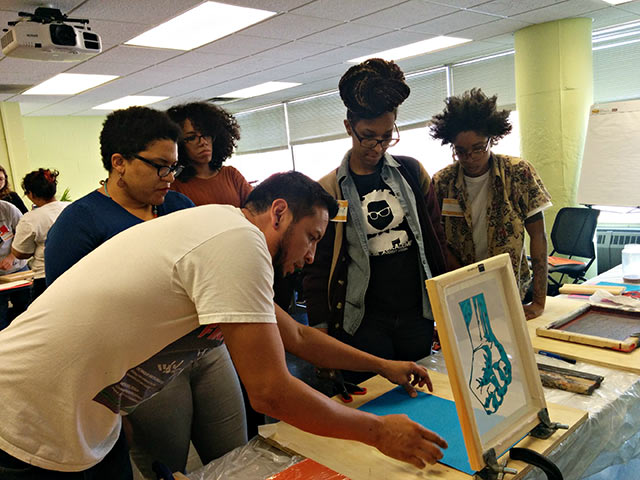 Remy demonstrates screen printing techniques at an early Rad Ed training in Chicago. (Photo: Kelly Hayes)
Remy demonstrates screen printing techniques at an early Rad Ed training in Chicago. (Photo: Kelly Hayes)
The original idea behind the project was to bring in highly experienced trainers to prepare young people to be skill sharers in their communities. Toward that end, we invited Remy, a Diné, Navajo, arts trainer from the Ruckus Society, a highly respected direct action training organization, to help run our first weekend-long event. Prior to the training, I made clear to Remy that he would be walking into a challenging room, sharing space with junior high school students, teenagers and 20-somethings who would push back if their politics and lived experiences weren’t respected. While the project was fueled by the momentum of Black Lives Matter, we had opened the project to all young people of color who might want to attend, and the applications we received reflected a much greater diversity than we would have expected. Black, Brown, Indigenous and mixed, our participants were the community members who wanted to show up to learn how to bring movement skills back to their communities during a time of upheaval, and it was their intentions that we needed to honor.
We only expected to have Remy with us for a single weekend, but the experiences we shared that weekend led him to return to the city, within a few short months, to help organize the project’s second major workshop.
At the end of the first weekend-long training, which focused on artful protest, we carried out an action in support of the reparations ordinance for survivors of police torture in Chicago. The banners our attendees created for that action were the subject of a great deal of discussion during the course of the weekend, as we talked through Native struggle, anti-Blackness and how oppressed people could build forward together. We all learned from each other in that space, both from the lived experiences and insights of young people, and the wisdom that Remy imparted from his experiences combating genocide on multiple fronts.
He would frequently remind us of the intersections between stolen land, stolen lives and stolen liberty. “The intersections of both our struggles are well documented outside of mainstream education,” he told me, reminding me that we could not allow the stories of our peoples to be separated into disconnected narratives. “There’s a history and a spirit of our cooperative resistance that this country’s history books try to rob us of,” he said. It was our need for each other, he reasoned, that led the power structure to paint us into our own corners.
By the end of the weekend, we created two banners for the reparations action: One bore the refrain of the movement for reparations – “Reparations Now!” – and one bore our own demand – “Transformation Now!”
 The banners that the Rad Ed youth participants created for the rally for reparations for survivors of police torture. (Photo: Sarah Jane Rhee)
The banners that the Rad Ed youth participants created for the rally for reparations for survivors of police torture. (Photo: Sarah Jane Rhee)
It was not enough, our participants reasoned, to seek to make the injured whole, because real change would require a new unity, and a total reorientation of society.
At the close of the action that we carried out that Monday, outside of City Hall, Page May, who co-organized the event, called those in attendance together in a large circle. She welcomed torture victims and Black youth into the center to join hands. She also invited members of a community whose abuse at the hands of police had recently been highlighted in the media. Then came something unexpected. Without any advance discussion, May widened the theme of the moment by welcoming all Indigenous people in attendance to join those standing in the center of the circle. She emphasized the struggles of Black people in Chicago, where Black youth are attacked, harassed and killed by police at a higher rate than any other demographic, but also paid respect to the fact that we were all standing on stolen land, and that Native people have continuously been victimized by the state on a massive scale nationwide.
In that moment, the connectivity of our struggles as victims of state violence was manifested in direct action. From Columbus’ torture and enslavement of the Taino people, which launched the horrors of the Transatlantic slave trade, to the plantations and death marches our peoples were condemned to, and the internalized and replicated oppressions that have at times torn us apart, I could feel who we all were, and who we were to each other. If only for a moment, the violence of white supremacy was met with a unified chorus of resistance, as those of us in the center locked hands, forming an inner circle that faced the larger crowd. We led the larger circle in a chant, calling out Black freedom fighter Assata Shakur’s words: “We have a duty to fight for our freedom! We have a duty to win! We must love each other, and protect each other! We have nothing to lose but our chains!”
After bringing her students to the action that night in lieu of classroom time, renowned Black activist and educator Mariame Kaba – one of my dearest mentors – wrote:
In the freezing cold, there was such powerful and healing energy all around me. I could feel the energy in my bones. I felt truly lucky to be there. I am so glad that I got to bring my students along. Each of them expressed a similar feeling. These are the intangible moments that are part of organizing. They are organic. Tonight was a special night. When we win the reparations ordinance, I will look back at this gathering as a seminal moment.
 Participants gathered in a circle at the reparations rally, literally centering Black youth, survivors of police violence and Indigenous community members. (Photo: Brit Schulte)
Participants gathered in a circle at the reparations rally, literally centering Black youth, survivors of police violence and Indigenous community members. (Photo: Brit Schulte)
Within a few months, we won the fight: Chicago became the first city in the country to attain reparations for victims of police torture. And while the fight was long and hard, I will always remember the campaign from the center of that circle, where we transcended the divide-and-conquer mentality of a power structure that wants us to view ourselves as more different than alike, and the would-be pundits who benefit from reinforcing such divisions.
We stood together, and we believed that we could win – and we were right.
Yes, it was just one moment at one action, and as builders of culture and community, we obviously have a lot of truth and history to reconcile, a lot of bickering to overcome and a lot of bridges to build. But many times, experiencing and falling in love with what’s possible is what begins the journey of transformation. And while I agree with William C. Anderson’s assessment that, “If we’re going to help one another we have to be honest about the history and the future,” I also agree with my friend Page May, who once told me, “We have to inhabit our history, but we also have to inhabit our dreams.”
I dream of freedom – for us all. And I believe we can get there together.
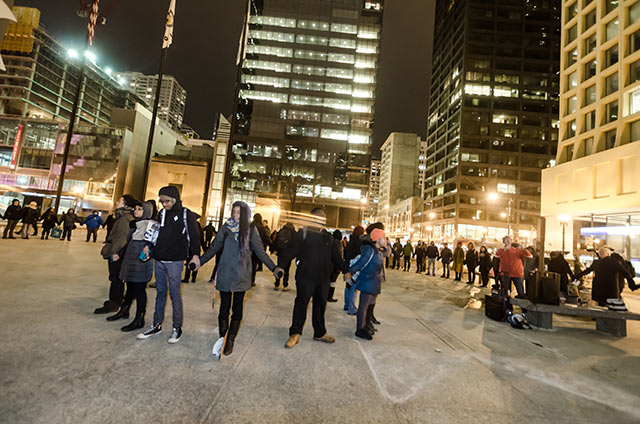 (Photo: Sarah Jane Rhee)
(Photo: Sarah Jane Rhee)
Our most important fundraising appeal of the year
December is the most critical time of year for Truthout, because our nonprofit news is funded almost entirely by individual donations from readers like you. So before you navigate away, we ask that you take just a second to support Truthout with a tax-deductible donation.
This year is a little different. We are up against a far-reaching, wide-scale attack on press freedom coming from the Trump administration. 2025 was a year of frightening censorship, news industry corporate consolidation, and worsening financial conditions for progressive nonprofits across the board.
We can only resist Trump’s agenda by cultivating a strong base of support. The right-wing mediasphere is funded comfortably by billionaire owners and venture capitalist philanthropists. At Truthout, we have you.
We’ve set an ambitious target for our year-end campaign — a goal of $250,000 to keep up our fight against authoritarianism in 2026. Please take a meaningful action in this fight: make a one-time or monthly donation to Truthout before December 31. If you have the means, please dig deep.
